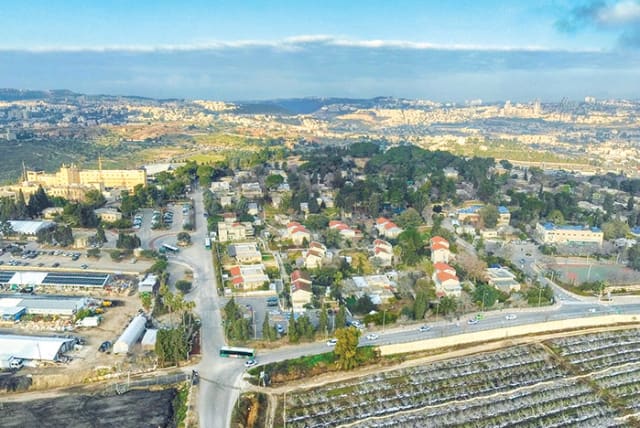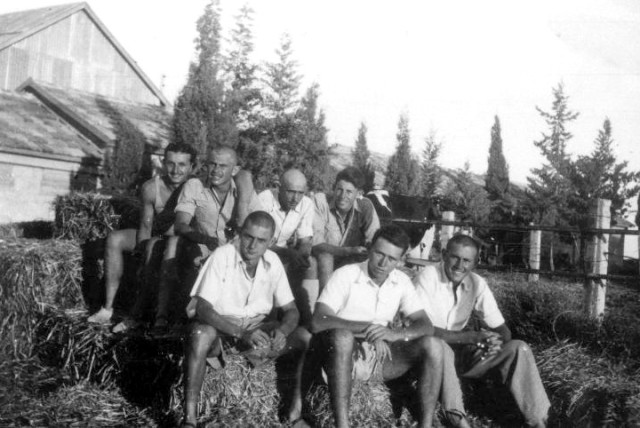Ramat Rachel: The hilltop kibbutz that encapsulates Israel’s history

Neighborhood Corner: Perched on a hilltop, overlooking modern-day Jerusalem and Bethlehem, is the picturesque and historic kibbutz of Ramat Rachel.

Established by members of the Gdud Ha’avoda (Labor Battalion) in 1926, Ramat Rachel was destroyed twice and reestablished. Its area is an enclave in the southern part of the municipal area of Jerusalem, near the neighborhoods of Arnona and Talpiot. Some members of the Jerusalem branch of Gdud Ha’avoda moved to settle on lands south of the city of Jerusalem that were purchased from the Greek Orthodox Church.
They named their settlement Ramat Rachel because of the kibbutz’s proximity to Bethlehem, where, according to tradition, the biblical matriarch Rachel is buried. The establishment of the kibbutz was assisted by the Jewish National Fund and was built on lands of the Keren Kayemeth LeIsrael-Jewish National Fund.
During the 1929 Arab riots, the kibbutz was abandoned and completely burned down by rioters from nearby villages. In the early 1930s, the kibbutz members returned and rebuilt everything. An elementary school, a kindergarten, and an infant house were established, and a cowshed, laundry, and bakery were built.
The ranks were strengthened by settlement cores from the youth movement and additional members who joined. The kibbutz stood firm during attacks during the Arab Revolt. During the events of Black Saturday on June 29, 1946, about 70 members were arrested by the British and imprisoned for a while in Rafah.
Today, the kibbutz has around 550 members, according to the Central Bureau of Statistics, and contains charming houses with plenty of room for members.
Battle of Ramat Rachel
The kibbutz was destroyed a second time with the outbreak of the War of Independence. During the war, the kibbutz changed hands between three forces: the Egyptian Army, the Jordanian Army, and the Hagana, which was reinforced by Irgun forces.
At the end of five days of fierce fighting, the Israeli side counted about 35 casualties (including 14 kibbutz members) and 84 wounded, one-third of whom were from the kibbutz. In other words, about half of the fighters in the kibbutz were wounded.
However, at the end of the war, Ramat Rachel remained within Israeli territory. The armistice line set between Israel and Jordan in 1949 surrounded the kibbutz almost entirely, leaving a small passage to the kibbutz from the nearby Talpiot neighborhood.
The renewal of settlement in the kibbutz after the war was initially controversial, and the kibbutz was reestablished in 1951. During the split in the Hakibbutz Hame’uhad (the United Kibbutz Movement), the kibbutz chose to belong to the Union of Kvutzot and Kibbutzim. A group of kibbutz members chose to leave Ramat Rachel and joined Kibbutz Ein Carmel.
Today, the kibbutz operates a renowned hotel and events hall. There is also a gym with two swimming pools on the site for hotel guests and external members. In the early 21st century, a new neighborhood with several buildings was constructed on part of the kibbutz’s land, expanding the Talpiot neighborhood. The kibbutz holds joint ownership with A.B. Planners, one of Israel’s major planning companies.
Archaeological excavations
The initial excavations, conducted by Benjamin Mazar and Moshe Stekelis in the early 1930s, revealed a burial cave from the Second Temple period in Ramat Rachel. Adjacent to it, in Givat Eliyahu, remnants of a city were found, which were identified with the biblical Netophah, an identification not accepted today.
The hill is situated on the narrow watershed (between Nahal Darga and Nahal Refaim) leading from Jerusalem to Bethlehem and Hebron, a topographic bottleneck on the Patriarchs’ route and thus a strategic point for building a fortress and a center of authority.
In the 1950s, excavations began at the site by famed Israeli archaeologist Yohanan Aharoni. Excavations conducted between 1959 and 1962 revealed layers from several periods. The most significant finds belong to a fortress, which Aharoni attributed to one of the last Judean kingdoms, while it served as a fortress for Assyria and Babylon.
The fortress is located on a hill near the kibbutz and is dated by the excavator to the 8th to 7th centuries BCE. Aharoni identified the site as Beit Hakerem, one of the places where beacons were lit at the end of the First Temple period.
Between 2004 and 2010, the archaeological site at Ramat Rachel was explored by Oded Lipschitz and an Israeli-German expedition. It was discovered that the fortress/palace underwent three main construction phases, serving as a fortified administrative center with a palace (during the intermediate phase) since the late Judean kingdom period.
The construction of the fortress is attributed by researchers to one of the Hasmonean Judean kingdoms, possibly to the reign of Hyrcanus. The fortress was surrounded by a closed wall, with an eastern entrance gate and a secret tunnel in the northern part. The center of the fortress included a spacious courtyard paved with crushed limestone, surrounded by rooms built of limestone and proto-Aeolic capitals.
In the second phase, the fortress was converted into an administrative center of the Babylonian province; and in the third phase, it became an elaborate administrative center of the Persian province of Yehud (many Yehud seals were found here).
Adjacent to the western tower of the palace, a garden with a terraced structure, covered garden soil, and a system of pools and pipes designed for irrigation was uncovered. A pollen analysis preserved in the temple’s plaster suggested a garden with cedar trees, walnut trees, and even an etrog orchard.
Lipschitz suggests that based on the style and technical ability evident in the findings, the palace dates back to the Persian period in Israel.
Aharoni also uncovered a complex of buildings and a large bathhouse from the 3rd century. In the bathhouse, a large number of bricks were found, some of which bore the stamp of the Tenth Legion Fretensis. Some of the bricks were discovered in the bathhouse’s floor.
Additionally, a statue base of the emperor Hadrian, Hasmonean rose impressions on jug handles, a ritual bath cave, and a coin from the Bar-Kochba period were found at the site.
In the southern columbarium, a cache of 15 golden Tyrian shekels was uncovered, possibly related to the half-shekel tax.
On the ruins of the fortress, the remains of a Byzantine village were found, with a church and a hall probably built over a catacomb church and possibly serving it. On the Byzantine village, remains of an Abbasid Muslim village were found, dating from between the 8th and 13th centuries.
The archaeological park was established in recent years by sculptor Ran Morin.
Points of interest
In 1954, artist David Palu created and gifted to the kibbutz a bronze statue depicting the matriarch Rachel as a Slavic peasant girl, holding a torch in one hand, while her other hand shelters her small children, nestled under her fluttering robe. The statue stands at the entrance to the Ramat Rachel Hotel. Hence, the statue is inscribed with the verse “And the children shall return to their borders.”
East of the kibbutz stands the Olive Pillar sculpture created by Morin in 1991. The sculpture consists of three olive trees standing on pillars 15 m. high and provides a panoramic view of Jerusalem.
Another unique lookout point was erected in memory of Yair Engel, born on the kibbutz, the grandson of two of its earliest members. Engel died in 1996 during his military service.
Designed by Morin, Mitzpeh Yair is constructed of chiseled stone that cloaks a centrally planted oak tree. The site offers a breathtaking view of the land between Jerusalem and Bethlehem that has been traveled for over three millennia. From the monument, ancient stone steps lead to the adjacent archaeological park.■
Jerusalem Post Store
`; document.getElementById("linkPremium").innerHTML = cont; var divWithLink = document.getElementById("premium-link"); if (divWithLink !== null && divWithLink !== 'undefined') { divWithLink.style.border = "solid 1px #cb0f3e"; divWithLink.style.textAlign = "center"; divWithLink.style.marginBottom = "15px"; divWithLink.style.marginTop = "15px"; divWithLink.style.width = "100%"; divWithLink.style.backgroundColor = "#122952"; divWithLink.style.color = "#ffffff"; divWithLink.style.lineHeight = "1.5"; } } (function (v, i) { });


